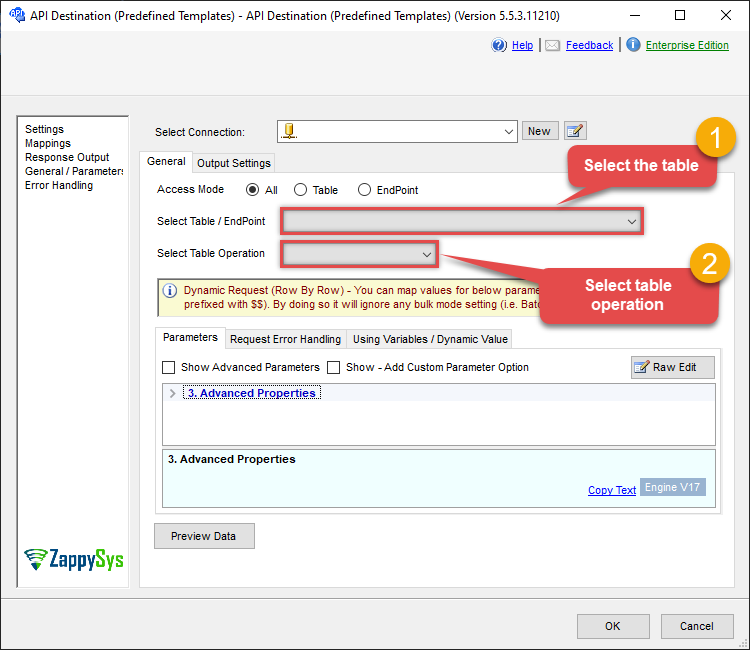Create Contacts
Name
create_contacts
Description
Related Tables
Parameters
| Parameter | Label | Required | Options | Description | |||||||||||||||||||||||||||||||||||||||||||||||||||||||||||||||||||||||||||||||||||||||||||||||
|---|---|---|---|---|---|---|---|---|---|---|---|---|---|---|---|---|---|---|---|---|---|---|---|---|---|---|---|---|---|---|---|---|---|---|---|---|---|---|---|---|---|---|---|---|---|---|---|---|---|---|---|---|---|---|---|---|---|---|---|---|---|---|---|---|---|---|---|---|---|---|---|---|---|---|---|---|---|---|---|---|---|---|---|---|---|---|---|---|---|---|---|---|---|---|---|---|---|---|---|
| There are no parameters | |||||||||||||||||||||||||||||||||||||||||||||||||||||||||||||||||||||||||||||||||||||||||||||||||||
Output Columns
| Label | Data Type (SSIS) | Data Type (SQL) | Length | Raw | Description |
|---|---|---|---|---|---|
| Id |
DT_I8
|
bigint
|
False |
||
| IsArchived |
DT_BOOL
|
bit
|
False |
||
| CreatedAt |
DT_DBTIMESTAMP
|
datetime
|
False |
||
| UpdatedAt |
DT_DBTIMESTAMP
|
datetime
|
False |
||
| [Dynamic Column] |
DT_WSTR
|
nvarchar(2000)
|
2000 | False |
[$parent.label$] |
Input Columns
| Label | Data Type (SSIS) | Data Type (SQL) | Length | Raw | Description |
|---|---|---|---|---|---|
| [Dynamic Column] |
DT_WSTR
|
nvarchar(2000)
|
2000 | False |
[$parent.label$] |
Examples
SSIS
Use Hubspot Connector in API Source component to read data or in API Destination component to read/write data:
Insert into Contacts table using API Destination
This Endpoint belongs to Contacts table, therefore you cannot work with it directly. Use this table and table-operation pair instead:

ODBC application
Use these SQL queries in your ODBC application data source:
Insert into Contacts
Inserts contacts
INSERT INTO Contacts(email, firstname, lastname,custom_checkbox, custom_date, custom_number)
VALUES ('john.doe@abc.com', 'John', 'Doe','true','2023-01-01', 100.55)Create multiple records - (BULK read / write from external source)
This examples shows how to perform bulk update using SOURCE clause. It reads data from external system (in this example MS SQL Server) and sends data to Hubspot using Bulk API
INSERT INTO Contacts
SOURCE(
'MSSQL' --ODBC or OLEDB
,'Data Source=localhost;Initial Catalog=Test;Integrated Security=true'
,'
''bob'' as firstname, ''rock'' as firstname, ''new-email1@abc.com'' as email
UNION
''sam'' as firstname, ''smith'' as firstname, ''new-email2@abc.com'' as email
)
create_contacts endpoint belongs to
Contacts
table(s), and can therefore be used via those table(s).
SQL Server
Use these SQL queries in SQL Server after you create a data source in Data Gateway:
Insert into Contacts
Inserts contacts
DECLARE @MyQuery NVARCHAR(MAX) = 'INSERT INTO Contacts(email, firstname, lastname,custom_checkbox, custom_date, custom_number)
VALUES (''john.doe@abc.com'', ''John'', ''Doe'',''true'',''2023-01-01'', 100.55)';
EXEC (@MyQuery) AT [LS_TO_HUBSPOT_IN_GATEWAY];Create multiple records - (BULK read / write from external source)
This examples shows how to perform bulk update using SOURCE clause. It reads data from external system (in this example MS SQL Server) and sends data to Hubspot using Bulk API
DECLARE @MyQuery NVARCHAR(MAX) = 'INSERT INTO Contacts
SOURCE(
''MSSQL'' --ODBC or OLEDB
,''Data Source=localhost;Initial Catalog=Test;Integrated Security=true''
,''
''''bob'''' as firstname, ''''rock'''' as firstname, ''''new-email1@abc.com'''' as email
UNION
''''sam'''' as firstname, ''''smith'''' as firstname, ''''new-email2@abc.com'''' as email
)';
EXEC (@MyQuery) AT [LS_TO_HUBSPOT_IN_GATEWAY];
create_contacts endpoint belongs to
Contacts
table(s), and can therefore be used via those table(s).
